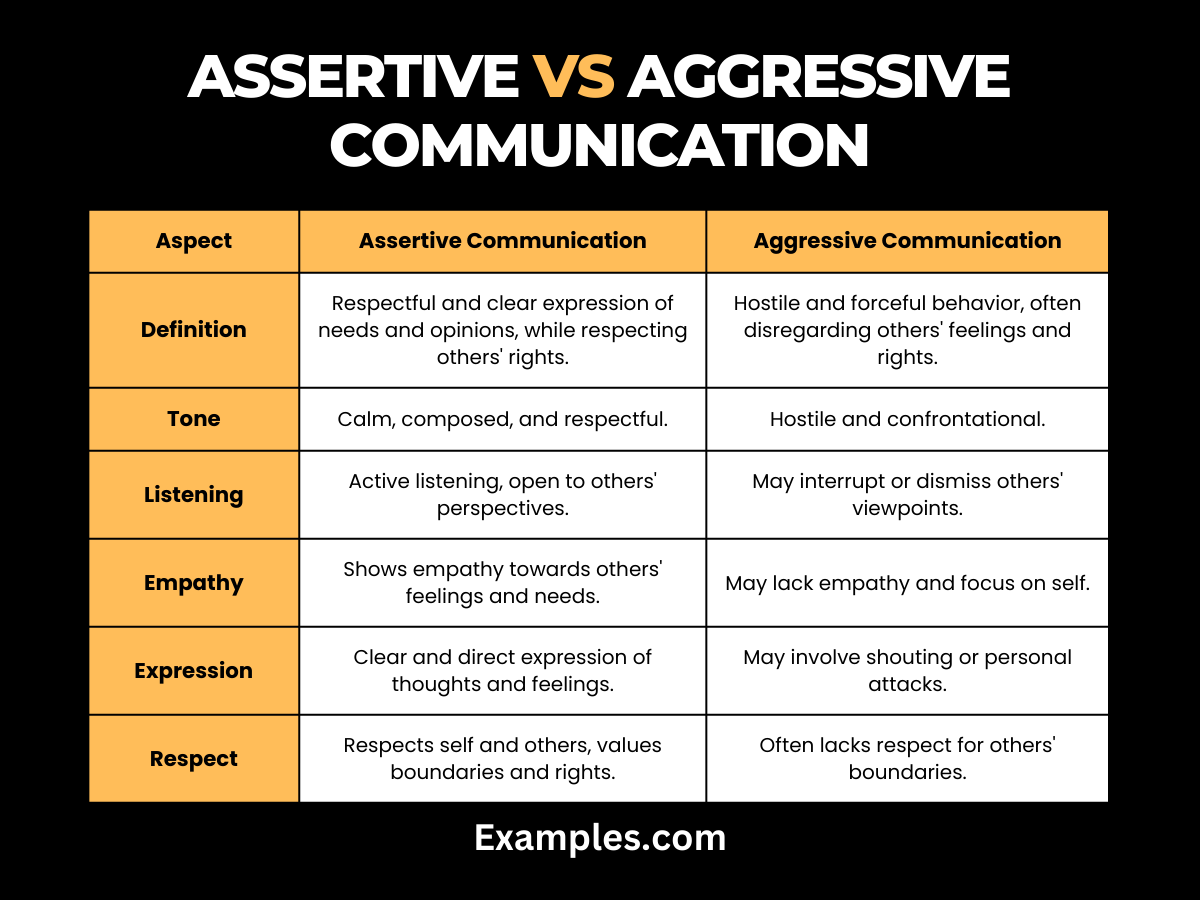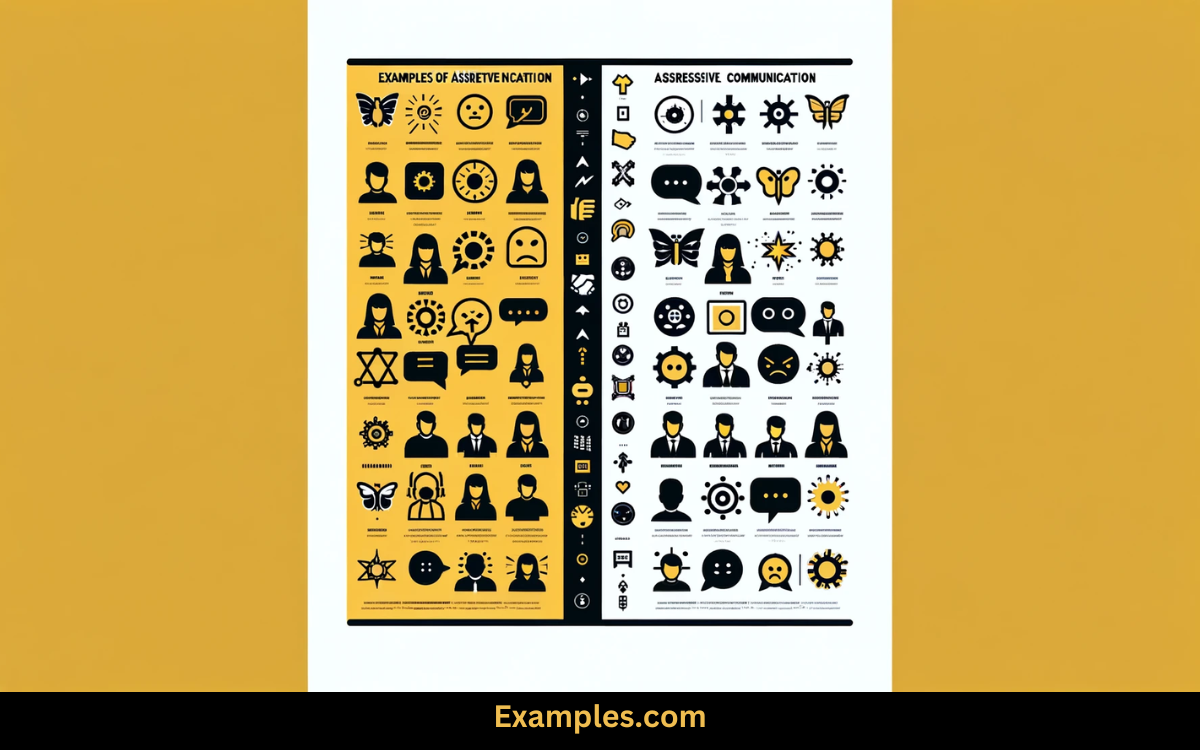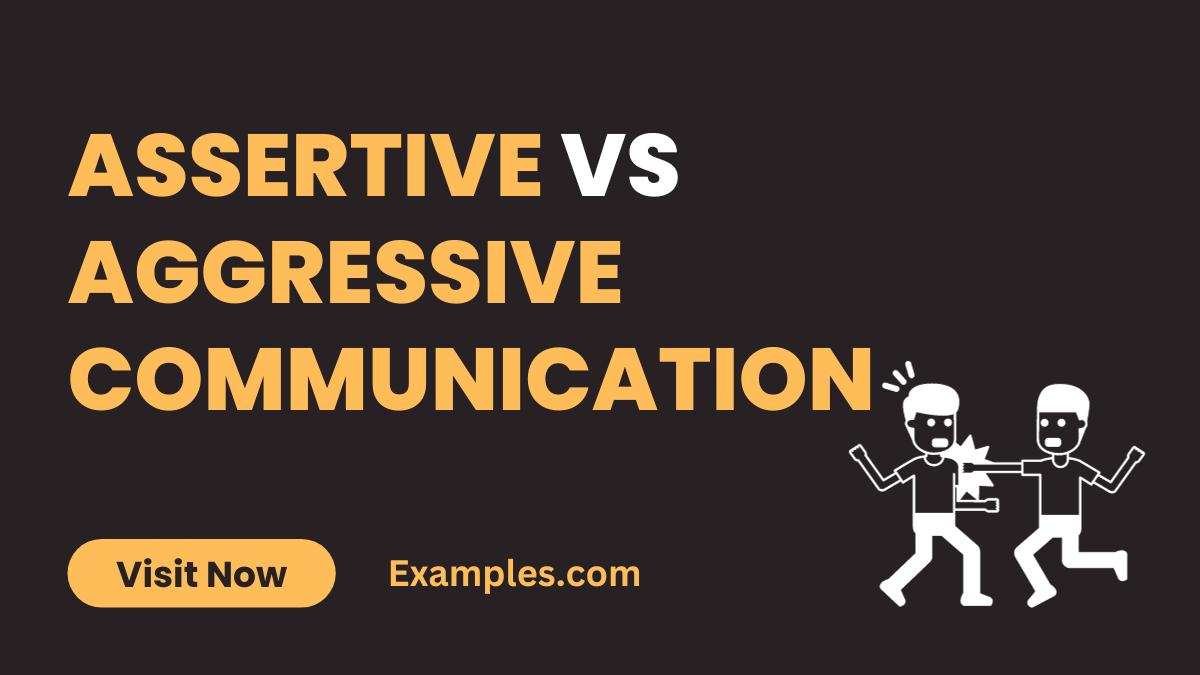19+ Assertive vs Aggressive Communication Examples
Communication is the cornerstone of human interaction, and the way we express ourselves can greatly impact our relationships and interactions with others. In this comprehensive guide, we delve into the fundamental differences between assertive and aggressive communication styles. We’ll explore real-life communication examples to shed light on the significance of choosing the right approach in various situations. Join us on this enlightening journey as we navigate the nuances of effective communication.
Difference Between Assertive vs Aggressive Communication
Effective communication is a vital skill in personal and professional life. Understanding the distinctions between assertive and aggressive communication is crucial for building healthy relationships and resolving conflicts. Below, we present a detailed comparison of these two communication styles in a table format:

| Aspect | Assertive Communication | Aggressive Communication |
|---|---|---|
| Definition | Assertive communication involves expressing your needs, opinions, and feelings in a respectful and clear manner, while also respecting the rights of others. It aims to assert one’s thoughts without infringing on others’ boundaries. | Aggressive communication is characterized by forceful and hostile behavior, often disregarding the feelings and rights of others. It tends to dominate conversations and impose one’s views forcefully. |
| Tone | The tone in assertive communication is calm, composed, and respectful. It seeks to maintain a harmonious atmosphere during conversations and values mutual understanding. | Aggressive communication typically involves a hostile and confrontational tone. It can create tension and defensiveness in interactions, hindering effective communication. |
| Listening | Assertive communicators are active listeners, open to others’ perspectives. They value feedback and seek to understand different viewpoints, promoting collaborative discussions. | Aggressive communicators may interrupt or dismiss others’ viewpoints. They often prioritize their own opinions and may not genuinely consider alternative ideas. |
| Conflict Resolution | Assertive communication seeks win-win solutions and promotes problem-solving. It aims to address conflicts constructively, emphasizing compromise and cooperation. | Aggressive communication may escalate conflicts and seek dominance. It often focuses on “winning” the argument at the expense of the relationship. |
| Empathy | Assertive communicators show empathy towards others’ feelings and needs. They acknowledge and validate emotions, fostering emotional connection and trust. | Aggressive communicators may lack empathy and focus on their own desires and objectives. They may disregard or belittle others’ emotions. |
| Body Language | Positive and open body language is common in assertive communication. It includes maintaining eye contact, using welcoming gestures, and having an approachable posture. | Aggressive communication may involve aggressive gestures and postures, such as pointing fingers, clenched fists, or invading personal space. |
| Expression | Clear and direct expression of thoughts and feelings is a hallmark of assertive communication. It aims to convey messages without ambiguity or manipulation. | Aggressive communication may involve shouting, using offensive language, or resorting to personal attacks. It often employs intimidation tactics. |
| Respect | Respect for oneself and others is a core value in assertive communication. It upholds the principle of treating individuals with dignity and valuing their boundaries and rights. | Aggressive communication often lacks respect for others’ boundaries. It can be invasive and disregard personal space or privacy. |
20 Examples of Assertive vs Aggressive Communication
Understanding the nuances between assertive and aggressive communication is vital for healthy and effective interpersonal relationships. Assertive communication strikes a balance between passivity and aggression, promoting respect and open dialogue. It involves expressing oneself honestly and directly, yet with respect for others’ rights and feelings. Conversely, aggressive communication disregards others’ feelings and rights, often leading to conflicts and strained relationships. Below are 20 examples illustrating these differences, with explanations on how to communicate assertively. 
Examples of Assertive Communication
- “I feel frustrated when meetings start late. Can we work on starting on time?”
Expressing personal feelings and requesting a change without blaming others. - “I appreciate your advice, but I have decided to follow a different approach.”
Acknowledging others’ input while confidently stating your own decision. - “I understand your point of view, but I see things differently. Here’s my perspective.”
Recognizing another’s opinion and assertively sharing your own. - “I need some time to think about this. Can we revisit this topic tomorrow?”
Setting boundaries and requesting time for consideration. - “It’s important for me to have a work-life balance. I prefer not to work late unless necessary.”
Clearly expressing personal values and setting work boundaries. - “I value our relationship, and when you say things like that, it hurts me.”
Communicating personal feelings in response to someone’s actions. - “Could we explore a solution that meets both our needs?”
Proposing collaborative problem-solving. - “I noticed an error in the report. Can we review it together to ensure accuracy?”
Pointing out a mistake and suggesting a cooperative approach. - “I would like to lead the next project as I feel ready for more responsibility.”
Expressing ambition and readiness for new challenges. - “I disagree with your point, but let’s find common ground.”
Disagreeing respectfully and encouraging a mutual understanding.
Examples of Aggressive Communication
- “You never do anything right!”
This statement blames and belittles the other person, showing no respect or understanding. - “Just shut up and do what I say!”
This is a clear example of disrespect and attempting to control the other person. - “If you had any brains, you’d know how to do this.”
Insulting someone’s intelligence is demeaning and aggressive. - “It’s all your fault we lost the client!”
Blaming and refusing to acknowledge one’s own role in a situation is aggressive. - “I don’t care what you think, just do it my way.”
Disregarding others’ opinions and insisting on control is a hallmark of aggression. - “You’re just useless, aren’t you?”
This demoralizing statement is a direct attack on someone’s self-worth. - “I’m not interested in your pathetic excuses.”
Refusing to listen and belittling others’ explanations is aggressive. - “Do it, or you’ll regret it!”
Using threats to get one’s way is an aggressive and intimidating tactic. - “Why can’t you be more like your sister?”
Comparing someone unfavorably to others is hurtful and aggressive. - “You better be on time, or else!”
Imposing demands with threats creates fear and is an example of aggression.
Comparison Between Assertive vs Aggressive Communication
Effective communication is a multifaceted skill, and understanding the differences between assertive and aggressive communication is essential for fostering positive relationships and resolving conflicts. In this comprehensive comparison, we outline the distinctions between these two communication styles in a table format:
| Assertive Communication | Aggressive Communication |
|---|---|
| Express thoughts, feelings, and needs respectfully and clearly, respecting others’ rights and boundaries. | Impose views forcefully, often disregarding others’ rights and feelings. |
| Calm, composed, and respectful, maintaining a harmonious atmosphere. | Hostile, confrontational, and abrasive, creating tension. |
| Actively listens, values feedback, seeks to understand viewpoints, promotes collaboration. | May interrupt, dismiss others’ opinions, prioritize own views. |
| Seeks win-win solutions, emphasizes problem-solving, values compromise and cooperation. | May escalate conflicts, focus on “winning” the argument, harm relationships. |
| Displays empathy towards others’ emotions and needs, acknowledges and validates feelings. | May lack empathy, prioritize personal desires and objectives. |
| Maintains positive and open body language, including eye contact, welcoming gestures. | May use aggressive body language, pointing fingers, or invading personal space. |
| Expresses thoughts and feelings clearly and directly, avoiding ambiguity or manipulation. | May use shouting, offensive language, personal attacks, resort to intimidation tactics. |
| Respects oneself and others, upholds dignity, values boundaries and rights. | Often disregards others’ boundaries, invasive, may disregard personal space or privacy. |
Positives and Negatives of Assertive and Aggressive Communication
Effective communication is a multifaceted skill, and understanding the differences between assertive and aggressive communication is essential for fostering positive relationships and resolving conflicts. In this comprehensive comparison, we outline the positives and negatives of both communication styles in a table format:
| Aspect | Assertive Communication | Aggressive Communication |
|---|---|---|
| Positives | – Respectful expression of thoughts and feelings.\n- Effective conflict resolution.\n- Enhanced relationships.\n- Clear understanding of messages.\n- Improved self-esteem. | – Assertiveness in expressing needs and opinions.\n- Immediate action in urgent situations.\n- Clarity of intent in communication. |
| Negatives | – Time-consuming in finding solutions.\n- Not always appropriate in high-pressure situations.\n- Requires practice and self-awareness. | – Damaged relationships due to tension and lack of trust.\n- Conflict escalation instead of resolution.\n- Emotional toll on communicators and recipients.\n- Lack of empathy for others’ emotions and needs.\n- Legal and social consequences for aggressive behavior. |
How would you distinguish aggressive from assertive?
Effective communication is a skill that can greatly impact personal and professional relationships. One critical aspect of communication is distinguishing between aggressive and assertive styles. In this guide, we’ll explore the key characteristics and methods for distinguishing aggressive from assertive communication.
Understanding Aggressive Communication
Before delving into the distinctions, let’s clarify what aggressive communication entails:
- Forceful Expression: Aggressive communication involves forceful expression of thoughts, feelings, or needs, often in a manner that disregards the rights and boundaries of others.
- Hostile Tone: It is characterized by a hostile and confrontational tone, which can create tension and defensiveness in interactions.
- Disregard for Others’ Opinions: Aggressive communicators may interrupt or dismiss the opinions and viewpoints of others, often prioritizing their own ideas.
- Conflict Escalation: Aggressive communication tends to escalate conflicts rather than resolve them, as it focuses on “winning” arguments over finding mutually agreeable solutions.
- Lack of Empathy: It often lacks empathy towards others’ emotions and needs, and aggressive individuals may disregard or belittle others’ feelings.
Identifying Assertive Communication
Now, let’s explore the characteristics of assertive communication that distinguish it from the aggressive style:
- Respectful Expression: Assertive communication involves expressing thoughts, feelings, and needs respectfully and clearly while respecting others’ rights and boundaries.
- Calm and Composed Tone: It maintains a calm, composed, and respectful tone, which contributes to a harmonious atmosphere during conversations.
- Active Listening: Assertive communicators are active listeners who value feedback and seek to understand different viewpoints, promoting collaborative discussions.
- Conflict Resolution: It aims to resolve conflicts effectively by seeking win-win solutions and emphasizing problem-solving, compromise, and cooperation.
- Empathy: Assertive communication displays empathy towards others’ emotions and needs, acknowledging and validating feelings, fostering emotional connection and trust.
Practical Tips for Distinguishing
Here are some practical tips to help distinguish between aggressive and assertive communication:
- Observe Tone and Body Language: Pay attention to the tone and body language of the communicator. Aggressive communication often involves aggressive gestures and postures, while assertive communication maintains positive and open body language.
- Listen Actively: Assess the listening behavior. Assertive communicators tend to be active listeners who seek to understand different viewpoints, while aggressive communicators may interrupt or dismiss others’ opinions.
- Evaluate Conflict Resolution Approach: Consider how conflicts are resolved. Assertive communication seeks win-win solutions, whereas aggressive communication may escalate conflicts and focus on “winning” at the expense of the relationship.
- Note Empathy and Respect: Look for signs of empathy and respect towards others’ emotions and boundaries. Assertive communicators value empathy and respect, while aggressive communicators may lack empathy and disregard boundaries.
- Assess Clarity and Directness: Examine the clarity and directness of expression. Assertive communication aims to convey messages without ambiguity or manipulation, while aggressive communication may involve shouting or personal attacks.
In conclusion, the journey through the nuances of assertive and aggressive communication underscores the profound impact these styles have on our relationships and personal development. Assertive communication, rooted in mutual respect and self-expression, not only enhances our self-esteem and confidence but also leads to more effective and harmonious interactions. The Mayo Clinic highlights that assertiveness helps in stress management, especially for those who tend to overcommit, by enabling them to say no respectfully??. It creates a direct and respectful way of communicating, ensuring messages are delivered successfully without being overshadowed by an inappropriate delivery method??.
On the other hand, aggressive communication, characterized by hostility and domination, may yield immediate results but at a significant long-term cost. This style often stems from a need for control or an inability to manage frustration and anger, leading to a disregard for others’ feelings and needs??. Such communication not only damages relationships but also creates a toxic and intimidating environment, making conflict resolution more challenging and undermining trust??. It also risks tarnishing one’s reputation and impeding professional growth, as aggressive communicators are often perceived as unapproachable and disrespectful??.
For further exploration of these communication styles, readers can refer to the comprehensive guides and resources provided by the Mayo Clinic (Assertiveness: Reduce stress, communicate better) and Choosing Therapy (Ways to Improve Your Aggressive Communication Style). These sources offer in-depth insights and practical advice on adopting more assertive communication patterns and understanding the implications of aggressive communication.



